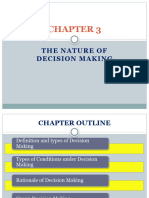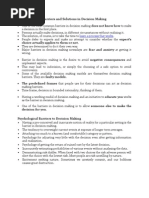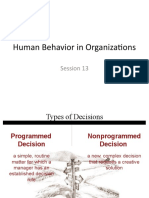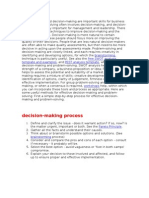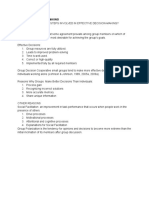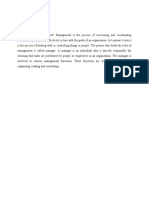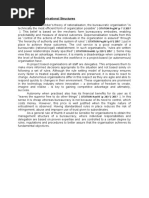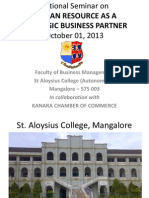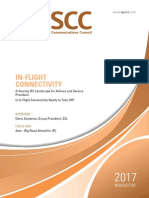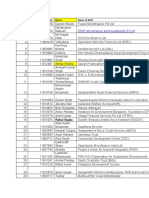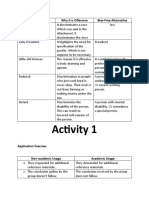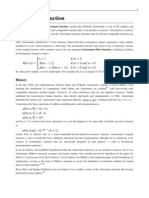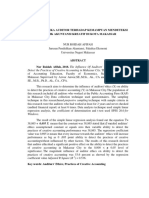0 ratings0% found this document useful (0 votes)
189 viewsSession 4 (Decision Making Styles)
Session 4 (Decision Making Styles)
Uploaded by
Kamran MukhtiarThere are two basic decision making styles - logical/rational thinkers who process sequentially, and intuitive/creative thinkers with high ambiguity tolerance. These dimensions result in four styles: directive (logical, efficient, short-term focused), analytic (rational, high ambiguity tolerance), conceptual (broad outlook, long-term focused), and behavioral (insightful, concerned with people, open to suggestions). Group decision making provides more information and perspectives but is time-consuming; advantages include increased acceptance of solutions while disadvantages include diffused responsibility and reduced efficiency. Techniques like brainstorming, nominal groups, and electronic meetings can improve group decision making by encouraging ideas and independent thinking while maintaining interaction.
Copyright:
Attribution Non-Commercial (BY-NC)
Available Formats
Download as PPT, PDF, TXT or read online from Scribd
Session 4 (Decision Making Styles)
Session 4 (Decision Making Styles)
Uploaded by
Kamran Mukhtiar0 ratings0% found this document useful (0 votes)
189 views10 pagesThere are two basic decision making styles - logical/rational thinkers who process sequentially, and intuitive/creative thinkers with high ambiguity tolerance. These dimensions result in four styles: directive (logical, efficient, short-term focused), analytic (rational, high ambiguity tolerance), conceptual (broad outlook, long-term focused), and behavioral (insightful, concerned with people, open to suggestions). Group decision making provides more information and perspectives but is time-consuming; advantages include increased acceptance of solutions while disadvantages include diffused responsibility and reduced efficiency. Techniques like brainstorming, nominal groups, and electronic meetings can improve group decision making by encouraging ideas and independent thinking while maintaining interaction.
Copyright
© Attribution Non-Commercial (BY-NC)
Available Formats
PPT, PDF, TXT or read online from Scribd
Share this document
Did you find this document useful?
Is this content inappropriate?
There are two basic decision making styles - logical/rational thinkers who process sequentially, and intuitive/creative thinkers with high ambiguity tolerance. These dimensions result in four styles: directive (logical, efficient, short-term focused), analytic (rational, high ambiguity tolerance), conceptual (broad outlook, long-term focused), and behavioral (insightful, concerned with people, open to suggestions). Group decision making provides more information and perspectives but is time-consuming; advantages include increased acceptance of solutions while disadvantages include diffused responsibility and reduced efficiency. Techniques like brainstorming, nominal groups, and electronic meetings can improve group decision making by encouraging ideas and independent thinking while maintaining interaction.
Copyright:
Attribution Non-Commercial (BY-NC)
Available Formats
Download as PPT, PDF, TXT or read online from Scribd
Download as ppt, pdf, or txt
0 ratings0% found this document useful (0 votes)
189 views10 pagesSession 4 (Decision Making Styles)
Session 4 (Decision Making Styles)
Uploaded by
Kamran MukhtiarThere are two basic decision making styles - logical/rational thinkers who process sequentially, and intuitive/creative thinkers with high ambiguity tolerance. These dimensions result in four styles: directive (logical, efficient, short-term focused), analytic (rational, high ambiguity tolerance), conceptual (broad outlook, long-term focused), and behavioral (insightful, concerned with people, open to suggestions). Group decision making provides more information and perspectives but is time-consuming; advantages include increased acceptance of solutions while disadvantages include diffused responsibility and reduced efficiency. Techniques like brainstorming, nominal groups, and electronic meetings can improve group decision making by encouraging ideas and independent thinking while maintaining interaction.
Copyright:
Attribution Non-Commercial (BY-NC)
Available Formats
Download as PPT, PDF, TXT or read online from Scribd
Download as ppt, pdf, or txt
You are on page 1of 10
Session 4
DECISION MAKING STYLES
BY: Hassan D Aslam
DECISION MAKING STYLES
There are two basic approaches of decision makers. First, some decision makers are logical and rational. They process in a sequential manner. Secondly, Some individuals think creatively and use their intuition/insight. They have high tolerance for ambiguity. When we diagram these two dimensions, four decision making styles are directive, analytic, conceptual and behavioral.
DECISION MAKING STYLES
Directive style These individuals are logical and efficient and typically fast decisions that focus on short term period. This style characterized by low tolerance for ambiguity and rational way of thinking. Analytic style focuses on high tolerance of ambiguity and combined with a rational way of thinking. These individuals prefer to complete information before making a decision.
DECISION MAKING STYLES
Conceptual Style represents someone who tends to be very broad in outlook and to look at many alternatives. These individuals tend to focus on long run and often look for creative solutions. Behavioral Style reflects individual who thinks insightfully but has a low tolerance of uncertainty. These decision makers work well with others, are open to suggestion and are concerned about the individuals who work for them.
GROUP DECISION MAKING
ADVANTAGES Group decision making provide more complete information than do individual once. Group brings a diversity of experiences and perspectives to decision making process. It increases acceptance of solution. If the people who will be affected by certain solution, and who will help implement it, participate in the decision they will be more likely to accept the decision and encourage others.
GROUP DECISION MAKING
Disadvantages Group decision making is time consuming. It takes time to assemble a group. Also, groups always take more time to reach a solution than an individual would take to make decision alone. In a group all members share responsibility but who is actually responsible. In an individual decision , it is clear who is responsible.
HOW CAN YOU IMPROVE GROUP DECISION MAKING
Brainstorming is an idea generating process that encourages alternatives while avoiding criticism. In a typical brainstorming session half-dozen to a dozen people sit together. The group leader states the problem and members explore different alternatives. No criticism is allowed.
HOW CAN YOU IMPROVE GROUP DECISION MAKING
Nominal group technique is a decision making technique in which the group members are physically present but operate independently. They secretly write a list of general problems and their solutions. The main advantage of this technique is it allow to the group to meet formally but doesnt restrict independent thinking.
HOW CAN YOU IMPROVE GROUP DECISION MAKING
Electronic Meeting is a type of nominal group technique in which participants are linked by computer. Issues are presented to the participants, who type their responses onto their computer screens. The major advantages of electronic meetings are anonymity, honesty and speed. Issues are presented to the participants, who type their responses onto computer screens. Individual comments as well as aggregate votes are displayed on a projection screen room.
CONGRATULATIONS YOU HAVE COMPLETED PLANNING STAGE OF MANAGEMENT.
You might also like
- Human Relation ApproachDocument11 pagesHuman Relation ApproachJoginder Grewal100% (1)
- Decision MakingDocument41 pagesDecision Makingkcirtap7489No ratings yet
- Group Decision MakingDocument21 pagesGroup Decision Makingfakeadnanmd09No ratings yet
- Decision Making For Business and Strategic ChoicesDocument21 pagesDecision Making For Business and Strategic ChoicesAlex AlexNo ratings yet
- Notes in Decision MakingDocument3 pagesNotes in Decision MakingJay GrijaldoNo ratings yet
- MOT Chapter 4. - Decision MakingDocument26 pagesMOT Chapter 4. - Decision MakingAnnalene de guzmanNo ratings yet
- Chapter 3 - The Nature of Decision MakingDocument19 pagesChapter 3 - The Nature of Decision MakingfaakhirahNo ratings yet
- Decision Making MatrixDocument21 pagesDecision Making MatrixRatna Dwi WulandariNo ratings yet
- Section 3 - Decison Making and Learning - Dimension in Managerial WorkDocument34 pagesSection 3 - Decison Making and Learning - Dimension in Managerial Workchicken XVIIINo ratings yet
- Section 3 - Decison Making and Learning - Dimension in Managerial WorkDocument34 pagesSection 3 - Decison Making and Learning - Dimension in Managerial Work16520800016No ratings yet
- OB IV Sem Unit 2Document40 pagesOB IV Sem Unit 2Fardeen RafiqueNo ratings yet
- KuldeeoDocument11 pagesKuldeeokdxpro22No ratings yet
- 8-Decision MakingDocument9 pages8-Decision MakingMerryll VillanuevaNo ratings yet
- Chapter 10 Decision MakingDocument16 pagesChapter 10 Decision Makingsoliashu24No ratings yet
- Organisational BehaviourDocument31 pagesOrganisational BehaviourJapleen ChadhaNo ratings yet
- Notes on Group Discussion_4d635c85508a24613c77055a2526eff0Document3 pagesNotes on Group Discussion_4d635c85508a24613c77055a2526eff0anoop6387276254No ratings yet
- Chapter 4.3Document13 pagesChapter 4.3Nur Aisyah AuniNo ratings yet
- Four General Decision Making StylesDocument11 pagesFour General Decision Making StylesЕвгения КазноваNo ratings yet
- Barriers in Decision Making 1Document4 pagesBarriers in Decision Making 1Anurag SinghNo ratings yet
- Group Decision MakingDocument9 pagesGroup Decision MakingmymadhavaNo ratings yet
- Presentation Group Decision MakingDocument14 pagesPresentation Group Decision MakingRakesh Shrestha0% (1)
- Foundations of Group Behaviour: BY Abhijith V ADocument19 pagesFoundations of Group Behaviour: BY Abhijith V AAbhijith V AshokNo ratings yet
- Applied Psychology CP-2 - 223377 (Himanshi Lahora) MA Psychology Sem 4Document8 pagesApplied Psychology CP-2 - 223377 (Himanshi Lahora) MA Psychology Sem 4Himanshi LahoraNo ratings yet
- MGT Chapter 3 FinalDocument40 pagesMGT Chapter 3 Finaldayoandianakrisheen8No ratings yet
- Decision - Making StyleDocument29 pagesDecision - Making Stylejme_pescasioNo ratings yet
- 7.1 Decision-Making and Problem-Solving SkillsDocument21 pages7.1 Decision-Making and Problem-Solving Skillsj.dabhi.182204No ratings yet
- Decision Making Organisation BehaviourDocument47 pagesDecision Making Organisation BehaviourIpokia OnlineNo ratings yet
- Session 12 13Document26 pagesSession 12 13KANIKA GORAYANo ratings yet
- Decision Making ProcessDocument7 pagesDecision Making Processspencer2003No ratings yet
- Decision-Making Styles and Techniques: Community Board Development: Series 5Document4 pagesDecision-Making Styles and Techniques: Community Board Development: Series 5hurriaanwar2593No ratings yet
- Decision Making VinodDocument9 pagesDecision Making VinodVinod100% (2)
- Ch05 - Problem Solving and Decision Making PDFDocument14 pagesCh05 - Problem Solving and Decision Making PDFIis MerlyNo ratings yet
- Working and Writing in Teams: Team InteractionsDocument19 pagesWorking and Writing in Teams: Team InteractionsSophie Allen SapienzaNo ratings yet
- Problem SolvingDocument35 pagesProblem SolvingFizza AwanNo ratings yet
- Chapter 3 - Decision MakingDocument18 pagesChapter 3 - Decision MakingNur Liza HazlinNo ratings yet
- Decision - MakingDocument20 pagesDecision - MakingAtashi AtashiNo ratings yet
- Decision Making, DecentralizationDocument19 pagesDecision Making, DecentralizationharpreetNo ratings yet
- Chapter 1 P S Hand Out 08032024 081739amDocument4 pagesChapter 1 P S Hand Out 08032024 081739amiqrabugti99No ratings yet
- Total Quality ManagementDocument65 pagesTotal Quality Managementp ganeshNo ratings yet
- Baname Doumongue Etienne FETTAH Salma Lemnaouar Nada BENCHAT NarjisDocument20 pagesBaname Doumongue Etienne FETTAH Salma Lemnaouar Nada BENCHAT NarjisChaimae ElNo ratings yet
- 3.2 Group Cohessiveness and Group Decision MakingDocument15 pages3.2 Group Cohessiveness and Group Decision MakingRiya KesarwaniNo ratings yet
- Group DiscussionDocument31 pagesGroup DiscussionAli KhanNo ratings yet
- Week 3 - Group CommunicationDocument40 pagesWeek 3 - Group CommunicationMotlatsi JosephNo ratings yet
- Decision MakingDocument5 pagesDecision MakingRyzhenSanchez-InfanteNo ratings yet
- Decision MakingDocument42 pagesDecision MakingVincent Bernardo100% (2)
- Decision Making CwtsDocument4 pagesDecision Making CwtsKohryuNo ratings yet
- Chapter 3 MGTDocument9 pagesChapter 3 MGTFarahain MasriNo ratings yet
- Decision Making ReviewerDocument8 pagesDecision Making ReviewerLESTER JAY ALFORQUENo ratings yet
- NSTP Decision-MakingDocument29 pagesNSTP Decision-MakingJay Grijaldo100% (5)
- Educ 206 Module For Chapter 4Document7 pagesEduc 206 Module For Chapter 4TeacherBechay VlogNo ratings yet
- Assignment 8thDocument3 pagesAssignment 8thnehagupta4915No ratings yet
- Group 1 2 3Document9 pagesGroup 1 2 3Hannah Faye InsailNo ratings yet
- Decision-Making Strategies: Faculty Teams That Reach ConsensusDocument38 pagesDecision-Making Strategies: Faculty Teams That Reach ConsensusIwan SantosoNo ratings yet
- Decision Making by Individuals & GroupsDocument35 pagesDecision Making by Individuals & Groupssgt_invictus100% (1)
- Principle of ManagementDocument14 pagesPrinciple of ManagementKARTHINA A/P C.RAJOO STUDENTNo ratings yet
- Accounts Term PaperDocument12 pagesAccounts Term PaperHarish UpmanyuNo ratings yet
- Group Dynamics ReportingDocument8 pagesGroup Dynamics ReportingJohn RiveraNo ratings yet
- Decision Making Skills - Management ProjectDocument26 pagesDecision Making Skills - Management ProjectPrathap Vimarsha100% (2)
- Effective Team DecisionDocument3 pagesEffective Team DecisionMia BogdanovicNo ratings yet
- TeamworkDocument36 pagesTeamworkWarren Kua100% (1)
- Understanding and Improving Group Decision-MakingFrom EverandUnderstanding and Improving Group Decision-MakingNo ratings yet
- Nebosh Igc Q/aDocument7 pagesNebosh Igc Q/amunawar100% (1)
- 3G Scrambling Code Planning As Part of The RNC DatabuildDocument5 pages3G Scrambling Code Planning As Part of The RNC DatabuildAmit GurungNo ratings yet
- Cs 604 Assignment No 2 SolutionDocument3 pagesCs 604 Assignment No 2 SolutionShan Khan100% (2)
- History of Math StuffDocument5 pagesHistory of Math StuffaemNo ratings yet
- 1 TQM Quality and Quality Control ADDocument46 pages1 TQM Quality and Quality Control ADSnigdha YadavNo ratings yet
- Dissertation de Marivaux La ColonieDocument4 pagesDissertation de Marivaux La ColoniePaperWritingServicesOnlineCanada100% (1)
- Civil Engineering and Environmental ScienceDocument2 pagesCivil Engineering and Environmental ScienceJustine Ryan L. MalgapoNo ratings yet
- Meeting 5Document26 pagesMeeting 5ano.sstoreNo ratings yet
- Freedom of Will and DeterminismDocument11 pagesFreedom of Will and DeterminismTanya MiyaNo ratings yet
- Diary Entry 1 - Organisational StructuresDocument1 pageDiary Entry 1 - Organisational StructuresQuetzalxochitl BuiNo ratings yet
- Learning The Concepts Through Synthesis: Unit 2Document51 pagesLearning The Concepts Through Synthesis: Unit 2Zelskie CastleNo ratings yet
- Consolidation Settlement Examples 3 - Solutions (2) - 2Document6 pagesConsolidation Settlement Examples 3 - Solutions (2) - 2Sujani MaarasingheNo ratings yet
- Rice Today Vol. 8, No. 4Document55 pagesRice Today Vol. 8, No. 4Rice TodayNo ratings yet
- HR As A Strategic Business PartnerDocument36 pagesHR As A Strategic Business PartnerProf Dr Chowdari Prasad100% (1)
- 3Document49 pages3Preet ChahalNo ratings yet
- Increasing and Decreasing Functions, Concavity and Inflection PointsDocument17 pagesIncreasing and Decreasing Functions, Concavity and Inflection PointsAnonymous Gd16J3n7No ratings yet
- Gilat Article APSCC 2017 10 - Is in Flight Connectivity Ready To Take Off PDFDocument7 pagesGilat Article APSCC 2017 10 - Is in Flight Connectivity Ready To Take Off PDFjose damianNo ratings yet
- Jac O' Keeffe E-Satsang April-May 2012Document15 pagesJac O' Keeffe E-Satsang April-May 2012RaduRoua100% (1)
- Resume Layout GuidanceDocument4 pagesResume Layout GuidanceNenk Srie NurainiNo ratings yet
- Dao Cach Ly GW55 Tra MyDocument8 pagesDao Cach Ly GW55 Tra MyPhước Khang NguyễnNo ratings yet
- Serialno Registerationnumber Name Name of Mfis: Esaf Microfinance and Investments (P) LTDDocument3 pagesSerialno Registerationnumber Name Name of Mfis: Esaf Microfinance and Investments (P) LTDMohammed AslamNo ratings yet
- Activity 1: Biased Term Why It Is Offensive Bias-Free AlternativeDocument2 pagesActivity 1: Biased Term Why It Is Offensive Bias-Free AlternativeOct Toberey MendozaNo ratings yet
- Conflict Resolution - Identity Crisis and Development in Africa - IntroductionDocument32 pagesConflict Resolution - Identity Crisis and Development in Africa - IntroductionJosh MentalNo ratings yet
- Ackermann FunctionDocument8 pagesAckermann Functionbit_richardNo ratings yet
- 1 Iceme2011 A10015Document5 pages1 Iceme2011 A10015kaluasma100% (1)
- Class-6 AsadDocument98 pagesClass-6 AsadAaleyaNo ratings yet
- Smart Jacket: Water Safety System Using GPS LocationDocument3 pagesSmart Jacket: Water Safety System Using GPS LocationGRD Journals0% (1)
- Akuntansi Kreatif PDFDocument14 pagesAkuntansi Kreatif PDFMarlim JayantaraNo ratings yet






